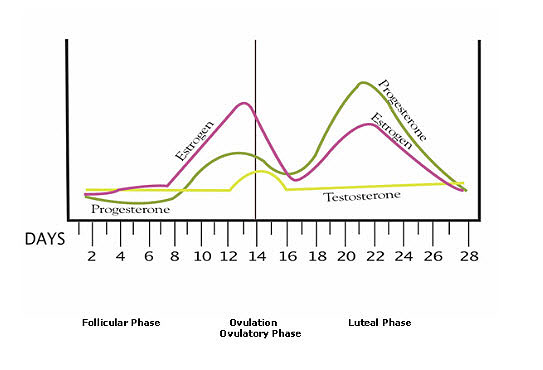How Does My Hormone Cycle Work?
Hormone Imbalance & Hormone Harmony
Hormone imbalance is best understood by knowing how a normal menstrual cycle works. A menstrual cycle is the result of a hormonal dance between the pituitary gland in the brain and the ovaries. Every month the female sex hormones prepare the body to support a pregnancy, and without fertilization there is menstruation (a period).
Menstrual Cycle
A menstrual cycle is determined by the number of days from the first day of one period to the first day of the next. So day one of the menstrual cycle is the first of full bleeding day of the period. A typical cycle is approximately 24 to 35 days (average 28 days for most women). It is not abnormal for a woman¹s cycle to occasionally be shorter or longer.
On Day 1 of the menstrual cycle, estrogen and progesterone levels are low. Low levels of estrogen and progesterone signal the pituitary gland to produce Follicle Stimulating Hormone (FSH). FSH begins the process of maturing a follicle (fluid-filled sac in the ovary containing an egg).
The follicle produces more estrogen to prepare the uterus for pregnancy. At ovulation, usually around Day 12 – 14, increased estrogen levels trigger a sharp rise in Luteinizing Hormone (LH) from the pituitary gland, causing release of the egg from the follicle.
The ruptured follicle (corpus luteum) now secretes progesterone and estrogen to continue to prepare the uterus for pregnancy. If the egg is not fertilized, estrogen and progesterone levels drop and, on Day 28, the menses begin.
The menstrual cycle occurs in three phases: follicular, ovulatory and luteal. The first half of the cycle is known as the follicular phase and the second half of the cycle is considered the luteal phase. Midway through the cycle between days 12 and 16 ovulation occurs, known as the ovulatory phase.
Hormone Imbalance
Knowing how a normal menstrual cycle works helps to understand the symptoms of premenstrual syndrome (PMS), perimenopause and menopause. Symptoms are often the result of too much or too little hormone(s).
During perimenopause hormone levels fluctuate as a result of fewer ovulations, so less progesterone is produced in the second half of the menstrual cycle. Periods can be erratic, skipped or have heavy bleeding /clots. Symptoms result from the change in ratio of estrogen to progesterone so the imbalance creates the symptoms.
During menopause, estrogen is no longer produced by the ovaries and is made in smaller amounts by the adrenal glands and in fat tissue. Estrogen is still produced in the body, but in lower amounts than younger cycling women. The most significant hormone change of menopause is the lack of progesterone, so a time of estrogen dominance and low progesterone.
Important Menstrual Cycle Hormones
Follicle Stimulating Hormone (FSH) - released from the pituitary gland in the brain, and stimulates the ovarian follicles (fluid-filled sacs on the ovary containing an egg or ovum) to mature.
Luteinizing Hormone (LH) - also released from the pituitary gland in the brain at ovulation, and causes the rupture of the mature ovarian follicle, releasing the egg.
Estrogen - One of the female sex hormones and often referred to as the ³growing hormone² because of its role in the body. Estrogen is responsible for growing and maturing the uterine lining (lining that is shed during menstruation) and also matures the egg prior to ovulation. Estrogen is produced mostly by the ovaries but also in smaller amounts by the adrenal glands and in fat tissue. It is most abundant in the first half of the menstrual cycle (follicular phase).
Progesterone - Another of the female sex hormones. It works in the body to balance the effects of estrogen and is often referred to as the relaxing hormone. Progesterone is produced after ovulation by the corpus luteum (sack that the egg comes from) and dominates the second half of the cycle (luteal phase). Progesterone¹s main job is to control the build up of the uterine lining and help mature and maintain the uterine lining if there is a pregnancy. If there is no pregnancy, our progesterone levels fall and the lining of the uterus is shed, beginning the menstrual cycle.
Testosterone - An important sex hormone for both women and men, although women have much lower levels. Is produced by the ovaries and adrenal glands (right on top of the kidneys), and has a surge at time of ovulation and slight rise just before the menses. Testosterone helps women maintain muscle mass and bone strength, enhances sex drive and helps with overall sense of well-being and zest for life.


